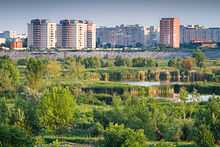Văcărești, Bucharest
Văcărești is a neighbourhood in south-eastern Bucharest, located near Dâmboviţa River and the Văcăreşti Lake. Nearby neighbourhoods include Vitan, Olteniței and Berceni. Originally a village, it was included in Bucharest as it expanded. Its name is related to the Wallachian aristocratic family of the 'Văcărești', with an etymology leading back to the Romanian văcar, "cow-herder" and the suffix -eşti.
The Monastery and quarter

The Văcăreşti Monastery, built by Nicholas Mavrocordatos in 1716, was located on the Văcărești hill, nowadays near Piața Sudului, but it was demolished in 1984 during the regime of Nicolae Ceauşescu, to make room for a Palace of Justice that was never built. It was the largest 18th-century monastery in Southeastern Europe and it had a church in the style of Curtea de Argeş Cathedral. It was designed to be also used as a fortress, being seized by the Russian army, under commander Nicholas Repnin, in May 1771 (in the context of the Russo-Turkish War and Pârvu Cantacuzino's rebellion).
Part of the buildings of monastery were used as prison. Inmates that were incarcerated at Văcăreşti prison include Richard Wurmbrand, Tudor Arghezi, Ioan Slavici, as well as Corneliu Zelea Codreanu and other members of the Iron Guard. The nearby hill was home to Arghezi's long-time residence, the house he nicknamed Mărţişor (nowadays a museum).
Jewish history
In the 19th century, many Jewish immigrants settled in Văcărești, most of them coming from Imperial Russia. Văcărești and Dudeşti were the areas where the poorest Jews settled. On 21 January 1941, the fascist Iron Guard started its coup against Ion Antonescu, with whom they had shared government power since September (see Legionnaires' Rebellion and Bucharest Pogrom). The Iron Guard legionnaires killed 125 Jews, including in Văcărești and Dudești. On 24 January 1941 Ion Antonescu suppressed the rebellion and the Iron Guard was banned and the members arrested.
Almost all the Jews emigrated to the newly created state of Israel after World War II. Văcărești was one of the quarters that was completely torn down by Ceaușescu and nowadays few traces of the old quarters remain.
Văcărești Lake

In the 1980s, Ceaușescu wanted to build a large amusement park (3 km²), demolishing a large part of the houses in the area and making place for a lake with a concrete bottom. However, it was never completed and it still remains barren as of 2009.
In 2002, 1.83 km² of the terrain were given for 49 years to a company owned by Australian citizen Tony Mikhael that wanted to invest €650 million and build some residential areas as well as a golf course, a hippodrome, a hotel and some clubs. The terrain itself is estimated to be worth about €500 million, as the land costs in the area around €300/m². Săptămâna Financiară argued that the concession of the terrain was illegal and that the Romanian state only gets around €0.28/m².
Further reading
- Gheorghe Leahu. Demolarea Mânăstirii Văcărești ("Demolition of the Văcărești Monastery"), (1997) București, Arta Grafică
- Anania, Lidia; Luminea, Cecilia; Melinte, Livia; Prosan, Ana-Nina; Stoica, Lucia; and Ionescu-Ghinea, Neculai, Bisericile osândite de Ceaușescu. București 1977–1989 (1995). Editura Anastasia, Bucharest, ISBN 973-97145-4-4. In Romanian. Title means "Churches doomed by Ceaușescu". p. 171–186 is about the Văcărești Monastery, including extensive photographs and architectural drawings.
References
| Wikimedia Commons has media related to Văcărești, Bucharest. |
- "Proiectul Văcăreşti, dezgropat în 2005", Evenimentul Zilei, 13 January 2005
- "Obuz pesedist în tunul alianței - Afacerea Văcărești", Săptămâna Financiară, no. 48, 13 February 2006 p. 1, 5
| ||||||||||||||||||||||||||||||||||||||||
Coordinates: 44°24′0.22″N 26°7′53.94″E / 44.4000611°N 26.1316500°E
